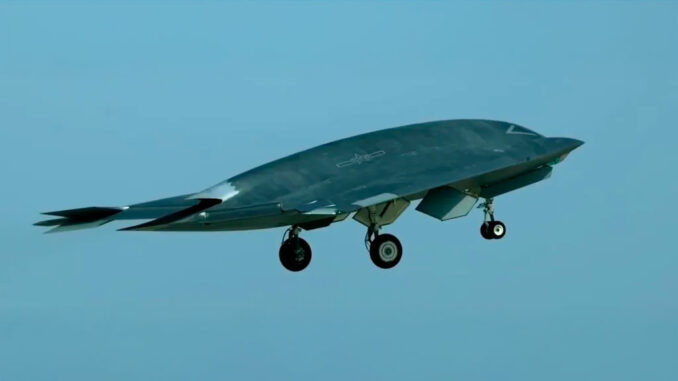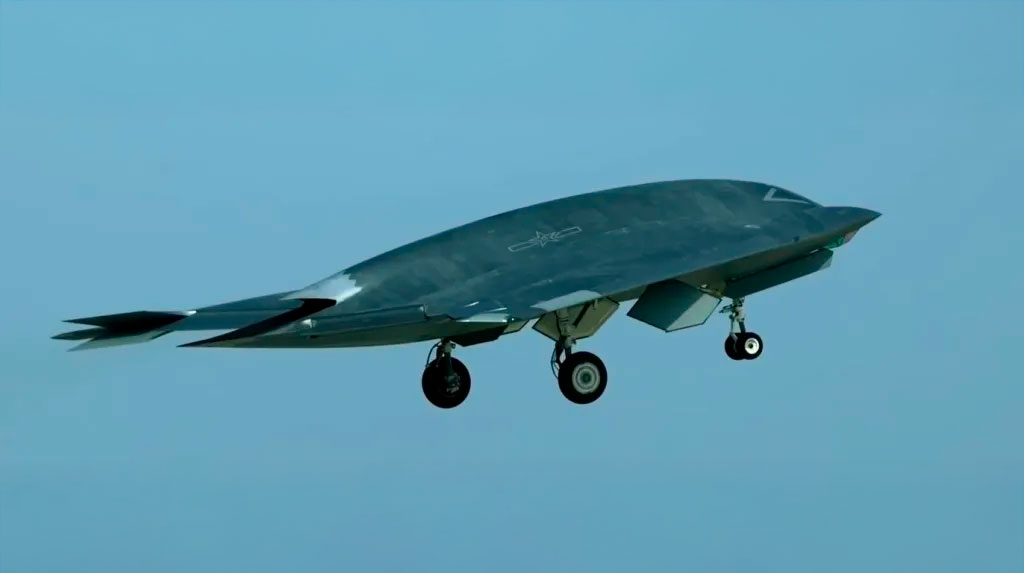
China unveils the GJ-11 “Mysterious Dragon” stealth drone, an UCAV flying alongside the J-20s, signaling a major shift in aerial combat.
Summary
China officially presents the People’s Liberation Army Air Force (PLAAF)’s “GJ-11” (designated “Mysterious Dragon”) unmanned combat drone. This stealth flying wing drone joins “human-piloted” fighters such as the J-20 and J-16D in flight. The GJ-11 is designed for air-to-ground strike missions, ISR (Intelligence, Surveillance, Reconnaissance) reconnaissance, and support for manned platforms. Its dimensions are estimated at a wingspan of approximately 14 m and a length of close to 12 m. The market for combat drones (UCAVs) is experiencing strong global growth, particularly in China. This new system reflects the rise of stealth and autonomous drones in Chinese air strategy, with major technological, strategic, and geopolitical implications.
The context of the GJ-11 unveiling
On November 11, 2025, in a video sequence released for the 76th anniversary of the founding of the Chinese Air Force, the PLAAF broadcast images of the GJ-11 in flight alongside the J-20 and J-16D. This unveiling comes shortly after satellite images captured three of these drones at Shigatse Air Base in the Tibet Autonomous Region between August and September 2025.
This context raises three important points:
- The public display of the aircraft indicates a sufficient level of maturity for official disclosure, a sign of progress towards an operational phase.
- The strategic positioning in Shigatse, close to the Indian border, illustrates a desire for both internal and external air projection.
- Its integration with manned aircraft in flight demonstrates a “human-drone” approach in Chinese aviation doctrine, which experts refer to as “manned-unmanned teaming.”
This is much more than just showing off a stealth drone: it is a public proof of concept of a new era in Chinese aerial warfare.
Technical characteristics of the GJ-11
According to several OSINT sources, the aircraft has a flying-wing configuration with no marked vertical tail, which reduces its radar signature.
Here is a summary of the estimated characteristics:
- Wingspan: approximately 14 m.
- Length: between 11.6 m and 12 m depending on the source.
- Estimated weight: some data suggests an empty weight of approximately 6,350 kg, with a maximum takeoff weight of around 20,215 kg (unofficial source).
- Maximum speed: up to ≈ 1,111 km/h according to GreyDynamics.
- Internal weapons/systems capacity: Two internal bays, each containing 4 to 6 guided munitions or electronic charges.
- Reduced signature: Reduced IR exhaust, composite materials, and stealthy shape.
These figures indicate that the GJ-11 is sized for tactical or even operational missions (strike or ISR) rather than simple demonstrators. The use of internal bays suggests a capacity to penetrate defended areas with guided munitions while maintaining appreciable stealth.
Missions and intended use
The original article emphasizes that the GJ-11 is “widely evaluated” for missions including air-to-ground strike, ISR, and possibly air-to-air combat or electronic warfare.
More specifically:
- Air-to-ground penetration strike: Thanks to its internal bays and stealth design, the aircraft can penetrate enemy defenses and deliver precision-guided munitions.
- ISR and surveillance: With potentially greater endurance than manned tactical jets, the GJ-11 can serve as an in-depth data collection platform.
- Support for manned platforms: Formation flying with the J-20 and J-16D suggests that it could act as an “unmanned wingman” or as a shield/decoy.
- Naval variant: Versions designated GJ-11H/GJ-21 are being discussed for deployment on aircraft carriers or amphibious ships.
This multi-mission capability shows that China is pursuing an integrated and flexible strategy, combining stealth drones, manned aircraft, electronic warfare, and data networks. The GJ-11 is not isolated; it is part of a weapons system.
The UCAV market and China’s position
The emergence of the GJ-11 comes at a time of strong market growth for combat drones (UCAVs) and drones in general. Some data:
- The global UCAV market was estimated at $11,466.8 million in 2023, with an annual growth rate of approximately 9.9% until 2034 (≈ $32,140 million).
- The Chinese drone market (civilian + military) is projected to grow from $13.12 billion in 2023 to $30.15 billion in 2031, at an annual growth rate of 10.96%.
- For the purely military segment in China: the market generated $4,288.8 million in 2024 and could reach $9,706.4 million by 2030.
These are significant figures: growth is strong, supported by Chinese government investment in the modernization of the armed forces. The GJ-11 is a concrete illustration of this strategy. In this context, China is no longer content with small surveillance drones: it is moving on to stealth UCAVs that are close to the level of piloted jets.


The strategic consequences for China and its adversaries
For China
The entry into service, or at least the quasi-entry into service, of the GJ-11 strengthens the PLAAF’s ability to project assets capable of penetrating enemy territory with reduced risk thanks to stealth. The fact that it can fly with a J-20 or J-16D indicates an operational doctrine focused on human-machine integration. This allows China to:
- increase its air deterrence in the Indo-Pacific region, particularly against adversaries or sensitive areas (e.g., the Indian border, the China Sea).
- develop an automated strike force that is more affordable and replicable than fleets of piloted aircraft alone.
- prepare for network warfare scenarios where drones, aircraft, and satellites exchange data in real time.
For adversaries
Rival air forces (United States, India, Japan, etc.) must now consider threats from stealth drones that are closer to the capabilities of piloted aircraft. This implies:
- The need for more advanced detection systems capable of locating platforms with low radar/IR signatures.
- a revision of air doctrines, including anti-stealth drone strategies, electronic warfare, and cyber defense.
- a possible domino effect of arms races in the field of stealth UCAVs, as countries such as Russia, India, Turkey, and France are also making progress in this area.
Technical and operational challenges
Despite the advances, several factors may limit or slow down the large-scale use of the GJ-11:
- Autonomy and operational autonomy: Human-machine integration is advanced, but complete autonomy in a contested environment (GPS jamming, electronic warfare) remains a challenge.
- Logistics and maintenance: Stealth drones require specific infrastructure (hangars, sensors, secure data links).
- Mass production cost: Although less expensive than some piloted aircraft, a device in this category remains costly.
- State of the art of use: Simply flying alongside piloted aircraft does not mean full operational capability. Some observers believe that the GJ-11 is not yet fully operational.
The introduction of the GJ-11 opens up several scenarios for the future:
- Development of naval variants (GJ-21) for deployment from Chinese aircraft carriers or amphibious ships. This would extend strategic reach in the China Seas and beyond.
- Integration of hypersonic or anti-ship munitions into internal bays, increasing the threat to opposing carrier strike groups.
- Evolution towards coordinated swarms of stealth drones, controlled or semi-controlled by a piloted aircraft or by a ground or airborne data center.
- Rise of the “stealth drone” as a central element of air forces, which could lead to a gradual reduction in traditional piloted aircraft in certain high-risk missions.
- For regional security, this could increase air tensions in the Indo-Pacific region, prompting neighboring countries to accelerate their own drone or counter-drone programs.
War Wings Daily is an independant magazine.